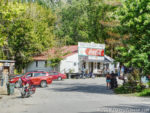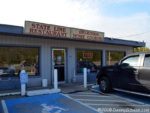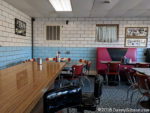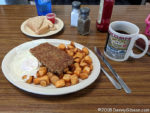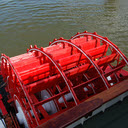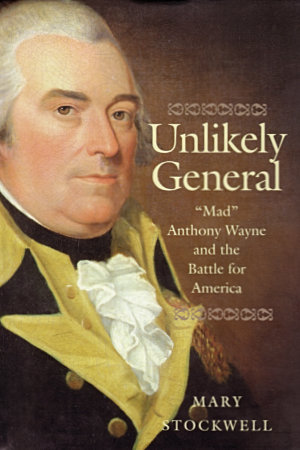 Anthony Wayne gave Fort Greene Ville and Fort Recovery their names. They were significant in both his life and mine although the level of significance is severely tilted toward Wayne. Fort Recovery is where the army led by Arthur St. Clair was nearly annihilated in 1791. It got its name when soldiers under Wayne’s command built a small fort there in 1793. Also built in 1793, Fort Greene Ville stood twenty some miles to the south and was Wayne’s home base during the Northwest Indian War. The treaty ending that war was signed there in 1795. The town that developed on the site of the abandoned fort adopted the shortened name Greenville. I grew up near the midpoint between Greenville and Fort Recovery and adopted Anthony Wayne as a hero at a very early age. I eventually figured out that much of the initial attraction was due the the cool bicorne hat he was commonly shown in, but the fact remains that I’ve known of General “Mad” Anthony Wayne nearly all of my life.
Anthony Wayne gave Fort Greene Ville and Fort Recovery their names. They were significant in both his life and mine although the level of significance is severely tilted toward Wayne. Fort Recovery is where the army led by Arthur St. Clair was nearly annihilated in 1791. It got its name when soldiers under Wayne’s command built a small fort there in 1793. Also built in 1793, Fort Greene Ville stood twenty some miles to the south and was Wayne’s home base during the Northwest Indian War. The treaty ending that war was signed there in 1795. The town that developed on the site of the abandoned fort adopted the shortened name Greenville. I grew up near the midpoint between Greenville and Fort Recovery and adopted Anthony Wayne as a hero at a very early age. I eventually figured out that much of the initial attraction was due the the cool bicorne hat he was commonly shown in, but the fact remains that I’ve known of General “Mad” Anthony Wayne nearly all of my life.
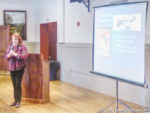 When I learned that Mary Stockwell would be discussing her new book about Wayne in nearby Lebanon, I jumped at the chance to attend. At a minimum, I hoped to learn what the word “unlikely” was doing in her book’s title. With what I knew of Wayne, he seemed the most likely of generals to attempt a turn around following St. Clair’s disaster. Turns out there was a lot I didn’t know.
When I learned that Mary Stockwell would be discussing her new book about Wayne in nearby Lebanon, I jumped at the chance to attend. At a minimum, I hoped to learn what the word “unlikely” was doing in her book’s title. With what I knew of Wayne, he seemed the most likely of generals to attempt a turn around following St. Clair’s disaster. Turns out there was a lot I didn’t know.
I knew about his time in Ohio with a fair level of detail, but I knew only highlights and generalities about his Revolutionary War days. I knew that he had been successful in several battles and that his biggest claim to fame at that time was taking Stoney Point, New York, from the British. I did not know that his personal life and lack of success in business meant that many of those in power did not have much confidence in the man. There was plenty of opposition to putting him in charge of what was essentially the entire army of the United States, and he was not at all the likely choice for the role I’d long assumed.
Some attending the presentation knew even less than I about Wayne’s pre-Indian War days. It was rather common, Stockwell noted, for people living in the east to know all about his Revolutionary War exploits and little or nothing about his post-revolution accomplishments and for the opposite situation to exist in our part of the country. Her book fills in details from both phases of his military career and the rest of his life as well. In doing that, she also provides glimpses of the birth of the United States of America and of the beginning of its westward expansion.
Much of Stockwell’s information on Wayne comes from reading actual letters written by and to him. This provides insight into his relationship with some of the most prominent figures of the day, such as Washington, Knox, Lafayette, St. Clair, and others, and with his friends and family. That last group, friends and family, was one I previously knew very little about. That personal life I referenced earlier included numerous involvements with women other than his wife, Polly. Correspondence between the two varied from frequent and loving to seldom and formal. His long absences and his womanizing were certainly related but which was the cause of the other isn’t really consistent. There is little doubt that he sometimes used his military activities as an excuse for staying away from home, but there is no doubt that his devotion to the new nation was completely genuine. The United States of America was something he was never anything but faithful to during its birth and infancy.
Stockwell skillfully weaves Wayne’s two wars together. There are some similarities, of course, such as the constant struggle to get government officials to feed and cloth the men they sent off to fight. But there are big differences in Wayne himself. He experienced periods of deep depression in both but during the Revolutionary War he was young, energetic, enthusiastic, and uncommonly handsome. By the time he set out to create the Legion of the United States from virtually nothing, old war wounds and severe gout might incapacitate him for days at a time. During that final campaign, his staff often wrapped his limbs in flannel and lifted him onto his horse out of sight of the troops.
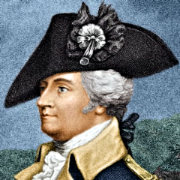 It was probably about sixty-five years ago that I was hooked by that super groovy hat and decided that the dude under it was my hero. It was only a few years later that I saw a painting of a hat-less Wayne and was shocked to learn it was the same person. That painting might even be the same one that appears on the cover of this book. It was at least similar. I recognized that there was more to a man than his hat and Wayne survived as a childhood hero. Inside Unlikely General, Mary Stockwell reveals a lot more than a high forehead. Anthony Wayne was not, as some have interpreted his nickname, insane, but he was a long way from perfect. Perhaps the fact that I’m much older now explains why I was less shocked at learning of the imperfections than I had been at my first sight of Wayne bare-headed.
It was probably about sixty-five years ago that I was hooked by that super groovy hat and decided that the dude under it was my hero. It was only a few years later that I saw a painting of a hat-less Wayne and was shocked to learn it was the same person. That painting might even be the same one that appears on the cover of this book. It was at least similar. I recognized that there was more to a man than his hat and Wayne survived as a childhood hero. Inside Unlikely General, Mary Stockwell reveals a lot more than a high forehead. Anthony Wayne was not, as some have interpreted his nickname, insane, but he was a long way from perfect. Perhaps the fact that I’m much older now explains why I was less shocked at learning of the imperfections than I had been at my first sight of Wayne bare-headed.
Anthony Wayne was once the most honored and well known military man in the country. Today, despite being on towns, streets, and other items, his name seems to be be barely recognized outside of Pennsylvania, Ohio, and Indiana. Hopefully this book will make his name a little better known. On the other hand, part of me can’t help but think he might never have fallen from the public consciousness if only he’d kept that hat on.
Unlikely General: “Mad” Anthony Wayne and the Battle for America, Mary Stockwell, Yale University Press, April 24, 2018, 9.2 x 6.1 inches, 376 pages, ISBN 978-0300214758
Available through Amazon.
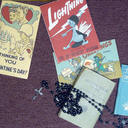 This picture is from my 2007 Blues, Books, & Battles trip. It was, as indicated by the title, a three parter. The blues part was a Patrick Sweany show at The Purple Fiddle in Thomas, West Virginia. I got there on the rather scenic US-50. Following a night in Thomas, I headed to Pittsburgh, Pennsylvania, for the book part. The target was a promotional event for a new book, The Lincoln Highway: Coast to Coast from Times Square to the Golden Gate, from Michael Wallis and Michael Williamson. I’ve met Wallis several times before and since but this was my first and only time meeting Williamson. Although I enjoyed that and wandering through the Heinz History Center, the real highlight was meeting Brian Butko and Bernie Queneau for the first time. I did not charge into battle for part three; I visited the Soldiers and Sailors Memorial where lots of military history is on display. Of particular interest and the reason for my visit, was a section devoted to the 78th Infantry Division. That’s the unit my dad was with in World War II.
This picture is from my 2007 Blues, Books, & Battles trip. It was, as indicated by the title, a three parter. The blues part was a Patrick Sweany show at The Purple Fiddle in Thomas, West Virginia. I got there on the rather scenic US-50. Following a night in Thomas, I headed to Pittsburgh, Pennsylvania, for the book part. The target was a promotional event for a new book, The Lincoln Highway: Coast to Coast from Times Square to the Golden Gate, from Michael Wallis and Michael Williamson. I’ve met Wallis several times before and since but this was my first and only time meeting Williamson. Although I enjoyed that and wandering through the Heinz History Center, the real highlight was meeting Brian Butko and Bernie Queneau for the first time. I did not charge into battle for part three; I visited the Soldiers and Sailors Memorial where lots of military history is on display. Of particular interest and the reason for my visit, was a section devoted to the 78th Infantry Division. That’s the unit my dad was with in World War II.
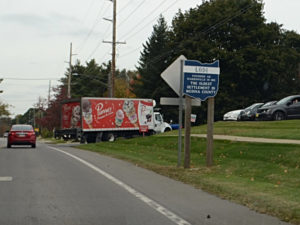
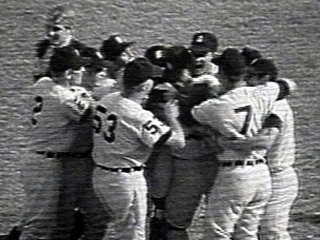 In 1968, it took a full seven games to determine a MLB World Series champion. The seventh game, which saw the Tigers top the Cardinals, was played on October 10.
In 1968, it took a full seven games to determine a MLB World Series champion. The seventh game, which saw the Tigers top the Cardinals, was played on October 10. Anthony Wayne gave Fort Greene Ville and Fort Recovery their names. They were significant in both his life and mine although the level of significance is severely tilted toward Wayne. Fort Recovery is where the army led by Arthur St. Clair was nearly annihilated in 1791. It got its name when soldiers under Wayne’s command built a small fort there in 1793. Also built in 1793, Fort Greene Ville stood twenty some miles to the south and was Wayne’s home base during the Northwest Indian War. The treaty ending that war was signed there in 1795. The town that developed on the site of the abandoned fort adopted the shortened name Greenville. I grew up near the midpoint between Greenville and Fort Recovery and adopted Anthony Wayne as a hero at a very early age. I eventually figured out that much of the initial attraction was due the the cool bicorne hat he was commonly shown in, but the fact remains that I’ve known of General “Mad” Anthony Wayne nearly all of my life.
Anthony Wayne gave Fort Greene Ville and Fort Recovery their names. They were significant in both his life and mine although the level of significance is severely tilted toward Wayne. Fort Recovery is where the army led by Arthur St. Clair was nearly annihilated in 1791. It got its name when soldiers under Wayne’s command built a small fort there in 1793. Also built in 1793, Fort Greene Ville stood twenty some miles to the south and was Wayne’s home base during the Northwest Indian War. The treaty ending that war was signed there in 1795. The town that developed on the site of the abandoned fort adopted the shortened name Greenville. I grew up near the midpoint between Greenville and Fort Recovery and adopted Anthony Wayne as a hero at a very early age. I eventually figured out that much of the initial attraction was due the the cool bicorne hat he was commonly shown in, but the fact remains that I’ve known of General “Mad” Anthony Wayne nearly all of my life.
 It was probably about sixty-five years ago that I was hooked by that super groovy hat and decided that the dude under it was my hero. It was only a few years later that I saw a painting of a hat-less Wayne and was shocked to learn it was the same person. That painting might even be the same one that appears on the cover of this book. It was at least similar. I recognized that there was more to a man than his hat and Wayne survived as a childhood hero. Inside Unlikely General, Mary Stockwell reveals a lot more than a high forehead. Anthony Wayne was not, as some have interpreted his nickname, insane, but he was a long way from perfect. Perhaps the fact that I’m much older now explains why I was less shocked at learning of the imperfections than I had been at my first sight of Wayne bare-headed.
It was probably about sixty-five years ago that I was hooked by that super groovy hat and decided that the dude under it was my hero. It was only a few years later that I saw a painting of a hat-less Wayne and was shocked to learn it was the same person. That painting might even be the same one that appears on the cover of this book. It was at least similar. I recognized that there was more to a man than his hat and Wayne survived as a childhood hero. Inside Unlikely General, Mary Stockwell reveals a lot more than a high forehead. Anthony Wayne was not, as some have interpreted his nickname, insane, but he was a long way from perfect. Perhaps the fact that I’m much older now explains why I was less shocked at learning of the imperfections than I had been at my first sight of Wayne bare-headed.










